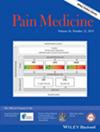A 10-Year Analysis of Application and Match Rates for Pain Medicine Training in the United States
IF 2.9
3区 医学
Q1 ANESTHESIOLOGY
引用次数: 0
Abstract
Objective We analyzed application and match rates for pain medicine training in the United States (US) and hypothesized that there would be 1.) greater growth in the number of training positions than applicants, 2.) higher match rates among US allopathic graduates relative to non-US allopathic graduates, and 3.) greater number of unfilled training positions over time. Design Retrospective, cross-sectional study of all applicants for pain medicine training in the US Method National Resident Matching Program (NRMP) data were obtained over a ten-year period (2014-2023). Match rates and applicant-to-position ratios were calculated and compared over time with linear regression. Comparisons were made with chi square tests. Results Growth in the number of annual training positions (261 to 377, 44% increase) exceeded growth in the number of interested applicants (398 to 415, 4% increase) (P < 0.001). Annual applicant-to-training position ratios decreased (1.5 to 1.1, P < 0.001). The representation of US allopathic graduates among incoming pain medicine fellows decreased over the study period (73% to 58%, P < 0.001) while US osteopathic graduates increased (9% to 28%, P < 0.001). Match rates increased for both US allopathic graduates (71% to 91%, P < 0.001) and non-US allopathic graduates (51% to 81%, P < 0.001). From 2018 to 2023, US allopathic graduates (79%) had higher match rates than US osteopathic graduates (60%, P < 0.001) and international medical graduates (57%, P < 0.001). More available annual training positions went unfilled over the study period (2% to 5%, P = 0.006). Conclusions Stagnant annual applicant volume and increasing number of available training positions have led to increasing match rates for pain medicine fellowship training. Fewer US allopathic graduates are pursuing pain medicine training. The increasing percentage of unfilled training positions warrants ongoing surveillance.美国疼痛医学培训申请和匹配率的十年分析
目标 我们分析了美国疼痛医学培训的申请率和匹配率,并假设:1.) 培训职位数量的增长幅度大于申请人数;2.) 相对于非美国全科毕业生,美国全科毕业生的匹配率更高;3.) 随着时间的推移,未填补的培训职位数量会更多。设计 对美国疼痛医学培训的所有申请者进行回顾性、横断面研究 方法 获取美国国家住院医师匹配计划(NRMP)十年间(2014-2023 年)的数据。计算匹配率和申请人与职位的比率,并用线性回归法比较不同时期的匹配率和申请人与职位的比率。比较采用卡方检验。结果 年度培训职位数量的增长(从 261 个增至 377 个,增幅为 44%)超过了感兴趣的申请者数量的增长(从 398 个增至 415 个,增幅为 4%)(P < 0.001)。申请人与培训职位的年度比率有所下降(从 1.5 降至 1.1,P < 0.001)。在研究期间,美国全科医学毕业生在新进疼痛医学研究员中所占比例有所下降(从 73% 降至 58%,P&P;lt; 0.001),而美国骨科医学毕业生的比例有所上升(从 9% 升至 28%,P&P;lt; 0.001)。美国全科毕业生(71% 到 91%,P &p;lt; 0.001)和非美国全科毕业生(51% 到 81%,P &p;lt; 0.001)的匹配率均有所上升。从 2018 年到 2023 年,美国全科毕业生(79%)的匹配率高于美国骨科毕业生(60%,P < 0.001)和国际医学毕业生(57%,P < 0.001)。在研究期间,有更多的年度培训职位空缺(2% 到 5%,P = 0.006)。结论 每年申请人数的停滞和可用培训职位数量的增加导致了疼痛医学研究员培训匹配率的上升。追求疼痛医学培训的美国全科毕业生越来越少。未填补培训职位的比例不断增加,需要持续进行监测。
本文章由计算机程序翻译,如有差异,请以英文原文为准。
求助全文
约1分钟内获得全文
求助全文
来源期刊

Pain Medicine
医学-医学:内科
CiteScore
6.50
自引率
3.20%
发文量
187
审稿时长
3 months
期刊介绍:
Pain Medicine is a multi-disciplinary journal dedicated to pain clinicians, educators and researchers with an interest in pain from various medical specialties such as pain medicine, anaesthesiology, family practice, internal medicine, neurology, neurological surgery, orthopaedic spine surgery, psychiatry, and rehabilitation medicine as well as related health disciplines such as psychology, neuroscience, nursing, nurse practitioner, physical therapy, and integrative health.
 求助内容:
求助内容: 应助结果提醒方式:
应助结果提醒方式:


